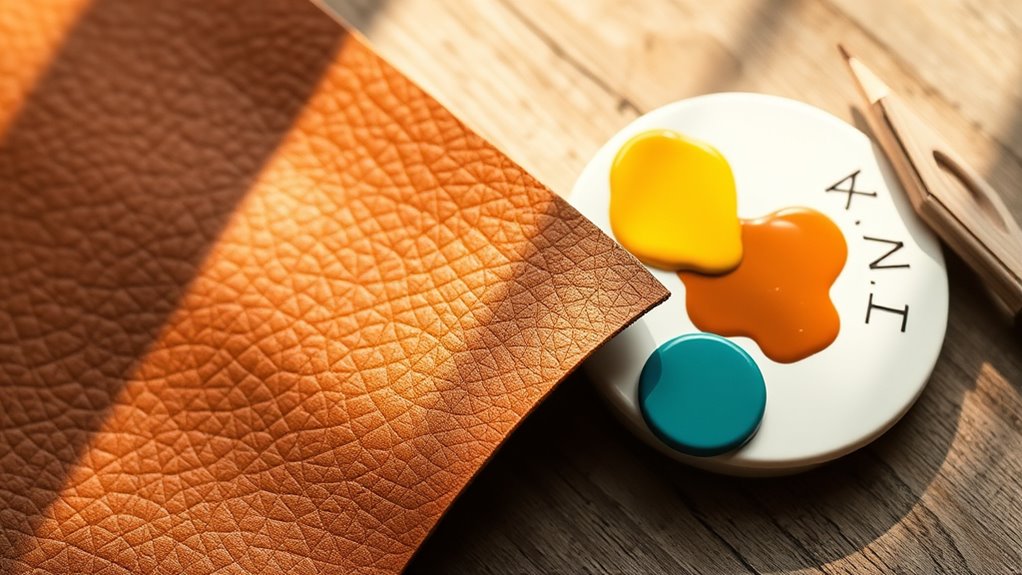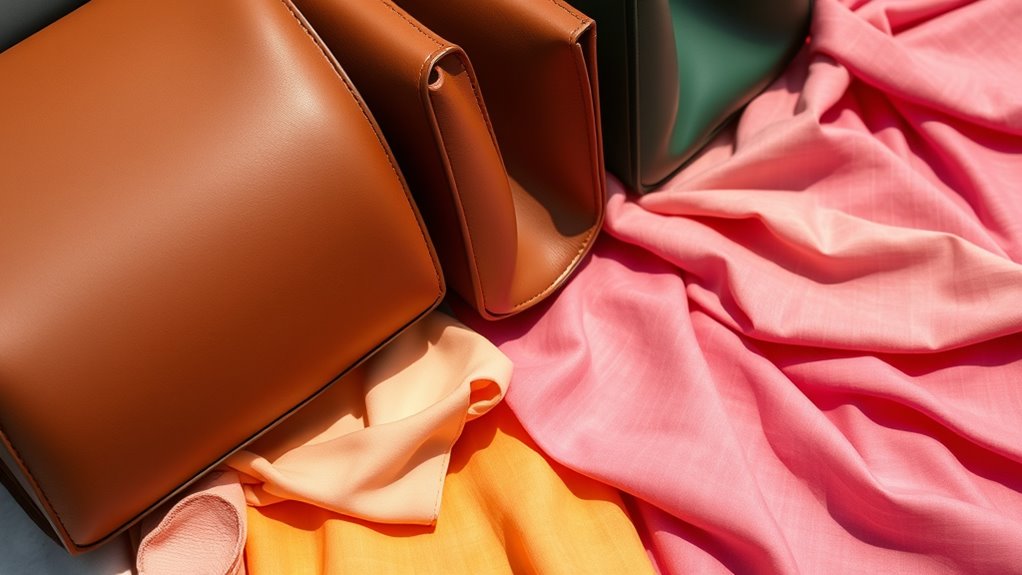Choosing vegan leathers and non-toxic paints helps you create products that are both stylish and eco-friendly. Vegan leathers made from biodegradable polymers break down naturally, reducing waste and pollution, while natural dyes and water-safe, non-toxic paints avoid harmful chemicals. These materials support sustainability and ethical values, ensuring your designs are safe for both the environment and people. Keep exploring to discover how these choices can transform your sustainable projects even further.
Key Takeaways
- Vegan leathers made from biodegradable polymers offer eco-friendly alternatives to traditional animal-based and synthetic materials.
- Non-toxic paints and dyes derived from natural sources reduce chemical runoff and environmental impact in coloring processes.
- Combining biodegradable leathers with natural dyes enhances aesthetic appeal while maintaining sustainability and safety.
- These materials support ethical production, promote biodiversity, and align with consumer demand for transparent, eco-conscious products.
- Using sustainable, non-toxic materials and colors helps brands reduce their carbon footprint and foster a greener future.

As awareness of environmental impact grows, sustainable materials and color choices become essential in design and manufacturing. You’re likely seeking options that minimize harm to the planet while maintaining style and functionality. One key area is the use of biodegradable polymers, which serve as eco-friendly alternatives to traditional plastics. These materials break down naturally over time, reducing landfill waste and pollution. When you opt for products made from biodegradable polymers, you’re supporting a cycle that lessens reliance on fossil fuels and decreases persistent plastic debris in ecosystems. Alongside these materials, natural dyeing techniques are gaining traction as a way to add vibrant color without harmful chemicals. Instead of synthetic dyes, you can choose textiles dyed with plant-based extracts, roots, or other natural sources that are renewable and less toxic. This approach not only reduces chemical runoff but also enhances the authenticity and depth of the colors, giving your products a unique, organic feel.
Incorporating biodegradable polymers in your designs means thinking beyond just the material itself. It involves considering the entire lifecycle, from sourcing to disposal. These polymers can be used in a variety of products, from fashion accessories to packaging, aligning with your commitment to sustainability. When combined with natural dyeing techniques, your creations become even more environmentally friendly. You avoid toxic mordants and dyes that can harm waterways and ecosystems, opting instead for methods that use water-efficient processes and eco-safe substances. This ensures that your production process remains low-impact and safer for workers and communities. Additionally, advances in colorfastness with natural dyes allow for durable, long-lasting hues that resist fading over time.
Choosing these materials and techniques doesn’t mean sacrificing quality or aesthetic appeal. Natural dyes can produce a spectrum of rich, vibrant hues that deepen over time, and biodegradable polymers can be engineered for durability and versatility. You can create products that are not only beautiful but also aligned with ethical principles. As you explore sustainable options, you’ll notice how these choices resonate with consumers seeking transparency and responsibility. Your commitment to eco-conscious materials demonstrates that style and sustainability can go hand in hand, reinforcing your brand’s integrity and appeal.
Ultimately, by prioritizing biodegradable polymers and natural dyeing techniques, you’re contributing to a more sustainable future. Your efforts help reduce environmental footprint, promote biodiversity, and support innovative, eco-friendly industries. It’s about making intentional decisions that reflect your values—creating products that are beautiful, functional, and kind to the planet. As you continue to embrace these sustainable materials and color methods, you’ll find that your designs not only stand out but also inspire others to follow suit, fostering a greener, more conscious world.
Frequently Asked Questions
Are Vegan Leathers as Durable as Traditional Leather?
Vegan leather can be quite durable, but its longevity often varies based on the material and quality. While some vegan leathers are designed to be resilient, traditional leather generally offers longer-lasting durability due to its natural strength and aging process. You might find vegan leather to be less prone to cracking, but it may not age as gracefully as traditional leather. Ultimately, choose quality vegan leather for better durability.
What Are the Environmental Impacts of Non-Toxic Paints?
Imagine a world where you’re a hero, like in a vintage comic, fighting pollution. Non-toxic paints offer significant environmental benefits by reducing chemical toxicity, which means fewer harmful emissions and safer ecosystems. They lower the risk of water and soil contamination, helping protect wildlife and human health. Choosing non-toxic paints minimizes your carbon footprint, making your projects eco-friendly and safer for future generations.
How Do Vegan Leathers Compare in Cost to Genuine Leather?
Vegan leather generally costs less than genuine leather, making it a more affordable option for many. You’ll find a favorable cost comparison, especially since vegan leathers are produced using synthetic or plant-based materials that often have lower manufacturing expenses. While some high-end vegan leathers can be pricey, overall, vegan leather affordability makes it an attractive alternative for eco-conscious consumers seeking stylish, budget-friendly options.
Can Non-Toxic Paints Be Used on All Materials?
You can’t use non-toxic paints on all materials without considering surface compatibility. About 60% of brands report paint adhesion issues on certain surfaces, especially plastics and fabrics. Non-toxic paints work well on many surfaces like wood and metal, but for vegan leathers, proper surface prep is vital to guarantee proper adhesion. Always check the paint’s specifications to avoid peeling or cracking, and test on a small area first.
Are There Health Risks Associated With Vegan Leather Production?
You might face some health risks with vegan leather production, especially if you have vegan leather allergies or sensitivities. Some vegan leathers contain chemicals that could cause skin irritation or allergic reactions. Additionally, non-toxic paint odor might linger during manufacturing, but it’s generally safer than traditional paints. To minimize risks, look for brands that prioritize non-toxic, eco-friendly materials and transparent production processes, ensuring you’re choosing a safer, healthier option.
Conclusion
By choosing vegan leathers and non-toxic paints, you’re actively reducing environmental harm and embracing a more colorful, sustainable future. These materials offer stylish alternatives that don’t sacrifice quality or ethics. Imagine your favorite accessory—how vibrant and eco-friendly can it be? Isn’t it time you made a conscious choice that benefits both your style and the planet? Every small step toward sustainable materials helps craft a brighter, greener world for everyone.










